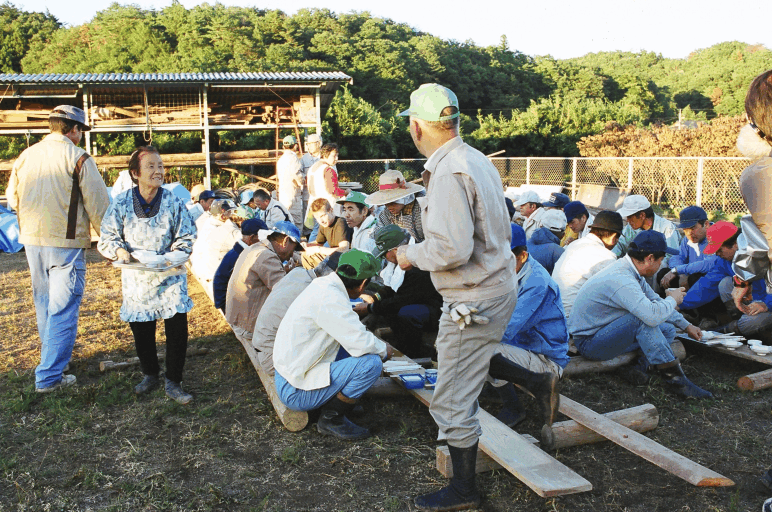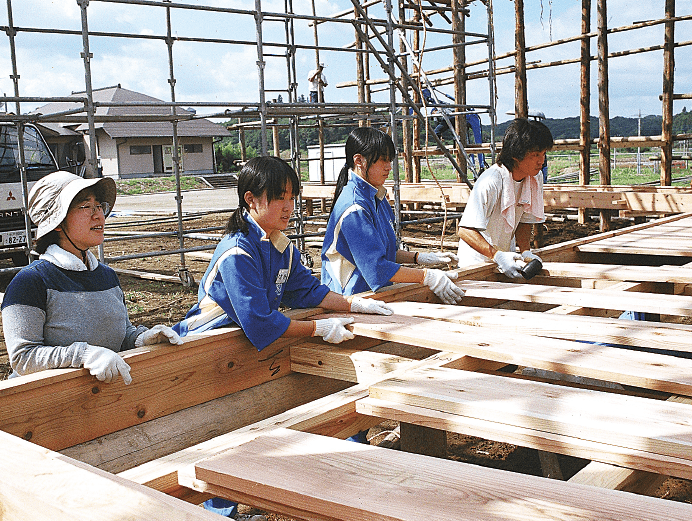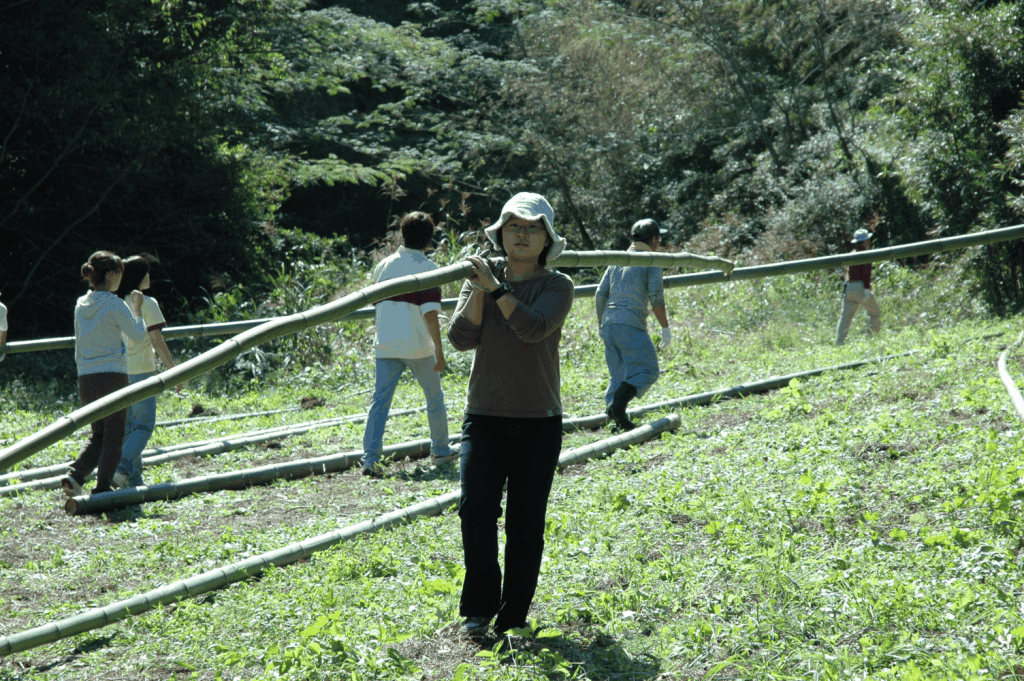目次
1.1 The Characteristics of Nishishiogo’s Revolving Stage
1.2 The residents of Nishishiogo Who Stood Up to Restore the Stage
1.3 The Stage Returns After Half a Century
1.4 Volunteers Played a Key Role in Revival
1.5 Preservation Association: A Timeline
・Stage survey by the Omiya Town Historical and Folklore Museum (until Jan. 1992)
・Nishishiogo Mawari Butai Preservation Association established
・”The Nishishiogo Revolving Stage” designated as a Town Tangible Folk Cultural Property
・Observed the assembly of the “Sugao Stage” in Akiruno City, Tokyo (Sugao Kumitate Butai Preservation Association)
・”The Nishishiogo Revolving Stage” designated as a Town Tangible Folk Cultural Property
・Observed the assembly of the “Sugao Stage” in Akiruno City, Tokyo (Sugao Kumitate Butai Preservation Association)
・Participated in the National Jishibai Summit (in Tomi City, Nagano Prefecture)
・Submitted activity plan and subsidy application to the town
・Submitted activity plan and subsidy application to the town
・The Preservation Association began activities toward assembly and performance
・Timber and bamboo cutting, stage assembly (from Sep.)
・Restoration commemorative performance (late Oct.)
・Stage disassembly (Nov.)
・Timber and bamboo cutting, stage assembly (from Sep.)
・Restoration commemorative performance (late Oct.)
・Stage disassembly (Nov.)
・Revival commemorative performance & 9th National Jishibai Summit (late Oct.)
・Nishiwakaza (local Kabuki troupe) formed and performed
・Nishiwakaza (local Kabuki troupe) formed and performed
・Designated as an Ibaraki Prefecture Tangible Folk Cultural Property
・Recruited stage assembly volunteers
・1st Regular Performance (late Oct.)
・Shiota Elementary School Children’s Kabuki participated
・Adopted for the Agency for Cultural Affairs’ “Hometown Culture Revitalization Project” (until 2003)
・1st Regular Performance (late Oct.)
・Shiota Elementary School Children’s Kabuki participated
・Adopted for the Agency for Cultural Affairs’ “Hometown Culture Revitalization Project” (until 2003)
・Gidayu, Tokiwazu, and Jishibai succession workshops held
・Stage props maintenance; “The Great Heisei Curtain Project” began
・Children’s Kabuki performed at the “Ibaraki Prefecture Local Folk Performing Arts Gathering”
・Stage props maintenance; “The Great Heisei Curtain Project” began
・Children’s Kabuki performed at the “Ibaraki Prefecture Local Folk Performing Arts Gathering”
・Gidayu, Tokiwazu, and Jishibai succession workshops held
・Stage props maintenance; Stage assembly succession workshops held
・2nd Regular Performance (late Oct.)
・Children’s Kabuki performed at the “Hometown Culture Children’s Festival in Tokai”
・Stage props maintenance; Stage assembly succession workshops held
・2nd Regular Performance (late Oct.)
・Children’s Kabuki performed at the “Hometown Culture Children’s Festival in Tokai”
・Received the Minister of Agriculture, Forestry and Fisheries Award (at the 3rd Village Traditional Culture Awards)
・Received the Grand Prize (at the 8th Furusato Event Awards)
・Adopted for support by the East Japan Railway Cultural Foundation (until 2018)
・5 towns and villages merged to form Hitachiomiya City (Oct. 6)
・Her Imperial Highness Princess Takamado viewed the Children’s Kabuki
・Received the Grand Prize (at the 8th Furusato Event Awards)
・Adopted for support by the East Japan Railway Cultural Foundation (until 2018)
・5 towns and villages merged to form Hitachiomiya City (Oct. 6)
・Her Imperial Highness Princess Takamado viewed the Children’s Kabuki
・Children’s Kabuki performed at the “Furusato Kabuki Festival (NHK Hall)” (Feb.)
・Nishiwakaza performed at Tokyo Station Marunouchi North Exit Dome “Marukita Traditional Space” (Sep.)
・Nishiwakaza performed at Tokyo Station Marunouchi North Exit Dome “Marukita Traditional Space” (Sep.)
・Received the 28th Suntory Prize for Community Cultural Activities
・Children’s Kabuki performed at the opening ceremony of the “18th National Lifelong Learning Festival Manabipia Ibaraki” (early Oct.)
・3rd Regular Performance (late Oct.); the Great Heisei Curtain completed
・Received the Ibaraki Image-Up Award (Incentive Award)
・Children’s Kabuki performed at the opening ceremony of the “18th National Lifelong Learning Festival Manabipia Ibaraki” (early Oct.)
・3rd Regular Performance (late Oct.); the Great Heisei Curtain completed
・Received the Ibaraki Image-Up Award (Incentive Award)
・Children’s Kabuki performed at the “Ibaraki Prefecture Local Folk Performing Arts Gathering”
・Children’s Kabuki performed at the “Children’s Folk Performing Arts Exchange Meeting” (in Sakuragawa City)
・Received the 1st The Tiffany Foundation “Award for the Preservation of Traditional Arts”
・The Nishishiogo Revolving Stage served as a satellite venue for the opening ceremony and a Jishibai performance venue for the “23rd National Cultural Festival Ibaraki 2008” (early Nov.)
・Received the 1st The Tiffany Foundation “Award for the Preservation of Traditional Arts”
・The Nishishiogo Revolving Stage served as a satellite venue for the opening ceremony and a Jishibai performance venue for the “23rd National Cultural Festival Ibaraki 2008” (early Nov.)
・Official website for the Nishishiogo Mawari Butai Preservation Association created by students from Ibaraki University’s Faculty of Engineering
・5th Regular Performance (mid-Oct.)
・5th Regular Performance (mid-Oct.)
西塩子の回り舞台「常陸大宮市常陸風土記1300年記念芸能公演」、「茨城県郷土民俗芸能のThe Nishishiogo Revolving Stage served as the venue for Hitachiomiya City’s “Hitachi Fudoki 1300th Anniversary Performing Arts” and the “Ibaraki Prefecture Local Folk Performing Arts Gathering” (Children’s Kabuki performance) *Start of stage rentals
・6th Regular Performance (mid-Oct.)
The Nishishiogo Revolving Stage served as the venue for the “Ibaraki Prefecture Local Folk Performing Arts Gathering” (Children’s Kabuki performance) and the “Udabe Music Festival” (a chorus festival of city elementary/junior high school songs by citizens)
・7th Regular Performance, postponed but held (mid-Oct.) after the stage was damaged by Typhoon Hagibis (Reiwa 1 East Japan Typhoon)
The Nishishiogo Revolving Stage served as the venue for the “Ibaraki Prefecture Local Folk Performing Arts Gathering” (Children’s Kabuki performance)
・8th Regular Performance (Oct. 25)






